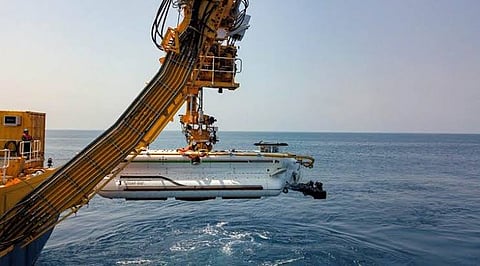
- Home
- Defence News
- Defence Appointments
- Defence Manufacturing
- Ministry of Defence

Visakhapatnam: To ramp up its influence among the littoral nations, India is offering its submarine rescue capabilities to friendly countries in the ongoing Indian Navy’s flagship exercise ‘Milan 2024’ here.
With submarine operations by various military powers—including China—growing by the day in the Indian Ocean and its nearby region, the Indian offer is aimed to endow the country with a strategic advantage.
“Many nations have expressed keen interest in making use of India’s capability. While we already have an ‘implementing agreement’ with Singapore, many other countries like South Africa and Japan may follow suit,” said Rear Admiral K. Venkatraman, Flag Officer Submarines (FOSM).
The FOSM is the Class Authority and Safety Class Authority for all classes of submarines in the Indian Navy.
Of the about 40 countries across the world that operate submarines, only six nations have developed the capability to deploy a Deep Submergence Rescue Vehicle (DSRV).
India has two DSRVs—one for the east coast and another for the western seaboard, respectively stationed at Vishakhapatnam and Mumbai. India acquired these vehicles in 2018 and in 2019. These vehicles can conduct rescue operations in submarines up to about 1,000 metres of depth.
Submarine rescue involves first locating a distressed or sunk submarine and then rescuing the survivors. Trapped personnel in submarines have three ways to come out—using the escape hatch, escaping from the torpedo tubes or being rescued by DSRVs.
DSRVs are either ship-mounted or air-transportable. India has both the capabilities.
In 2021, an India DSRV had also headed to participate in the rescue operations of the ill-fated Indonesian Navy submarine Nanggala-402 which sank on April 24, 2021 in the waters north of Bali.
“From the time of receiving a distress call from a submarine, the current Indian Navy capabilities can actually undertake rescue operations in 72-96 hours,” a navy official said.
In another underscoring of the ongoing ‘Atmanirbharta’ or self-reliant effort, a major component of the DSRV technology has been indigenously shaped at the Hindustan Shipyard Ltd, Vishakhapatnam, which has spearheaded the development while the core technology has been supplied by M/s James Fishes Defence, UK.
(Defence Watch– India’s Defence News centre that places the spotlight on Defence Manufacturing, Defence Technology, Strategy and Military affairs is on Twitter. Follow us here and stay updated.)
